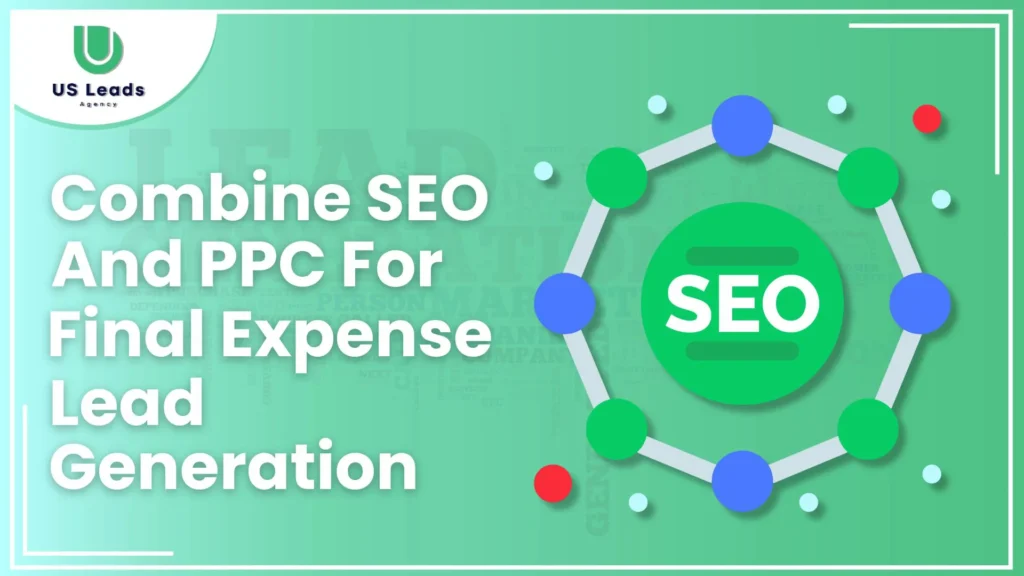
The final expense insurance market is highly competitive, requiring a multifaceted approach to stand out. Combining Search Engine Optimization (SEO) and Pay-Per-Click (PPC) advertising can amplify your reach, attract quality leads, and drive higher conversions.
This guide outlines effective methods to integrate SEO and PPC for final expense lead generation for maximum impact.
Key Takeaways:
- Synergy of SEO and PPC: Build a balanced, powerful lead-generation strategy.
- Data-Driven Refinement: PPC insights can improve SEO targeting and content.
- Local Strategies Matter: Pair local SEO with geo-targeted PPC ads for higher lead quality.
- Consistent Optimization: Regular tracking and testing refine outcomes.
- ROI Measurement: Evaluate the combined efficiency of SEO and PPC for cost-effective lead generation.
Table of Contents
What is Final Expense Lead Generation?
Final expense lead generation identifies potential customers for final expense insurance, a policy covering end-of-life costs like funerals, medical bills, or debts. Effective strategies ensure your focus is on qualified prospects, improving sales efficiency and providing families with financial peace of mind.
SEO and PPC For Final Expense Lead Generation:
1. Understand The Roles of SEO and PPC:
- SEO: Drives long-term organic traffic by optimizing your site and content for search engines.
- PPC: Delivers immediate results, ideal for testing campaigns, targeting specific audiences, and quick lead generation.
When used together, these strategies complement each other, creating a robust and efficient approach.
2. Align Keyword Strategies For Both Channels:
- Research keywords with tools like Google Keyword Planner or SEMrush.
- Use keywords like $10 final expense leads, live transfer final expense leads, and direct mail final expense leads.
- Optimize your site content for these terms to improve organic rankings.
- Bid on these keywords in PPC to capture paid traffic while monitoring keyword performance to refine both strategies.
3. Develop High-Quality Landing Pages:
- SEO-Optimized Pages: Use relevant keywords, fast load times, and informative content addressing common queries.
- PPC Landing Pages: Create conversion-focused pages with clear CTAs, simplified forms, and trust signals like testimonials.
- Use PPC insights to adjust content, headlines, or layout for better organic results.
4. Combine Remarketing With SEO:
- Use PPC retargeting ads to re-engage visitors from organic traffic.
- Personalize campaigns based on user interactions with your site.
- Build stronger brand recall to enhance the performance of both channels.
5. Share Campaign Insights:
- Leverage PPC data on high-converting keywords for SEO content creation.
- Analyze organic traffic data to identify popular topics for PPC ad copy.
- Maintain consistent messaging and offers across both channels.
6. Focus on Local SEO and Geo-Targeted PPC:
Final expense insurance is often sold locally, making local strategies vital:
- Local SEO: Optimize your Google Business Profile with accurate information. Use keywords like exclusive final expense leads or final expense leads free.
- Geo-Targeted PPC Ads: Focus campaigns on regions with high demand for final expense insurance.
7. Regular Monitoring and Optimization:
Track and optimize key metrics for both SEO and PPC:
- For PPC: CTR, CPL, and conversion rates.
- For SEO: Organic traffic growth, engagement rates, and keyword rankings.
- Adjust strategies based on data insights to maximize results.
8. Measure ROI Holistically:
Evaluate the combined impact of SEO and PPC:
- Assess overall cost per acquisition (CPA).
- Determine how PPC traffic influences organic engagement.
- Balance budgets to allocate resources effectively while maintaining both strategies.
Conclusion – SEO and PPC for Final Expense Lead Generation:
Combining SEO and PPC creates a powerful approach for final expense lead generation. This integration enables you to harness the strengths of both strategies, refine efforts with data-driven insights, and consistently deliver results. Begin by analyzing your current methods, setting clear objectives, and implementing a cohesive plan to achieve growth in this competitive market.
FAQs:
What is PPC in lead generation?
PPC is a paid advertising model where businesses pay for each click on their ads. It delivers immediate traffic and is effective for targeting specific demographics.
How to generate leads with SEO?
SEO generates leads by improving website visibility in search results, driving organic traffic, and optimizing content to meet user intent.
